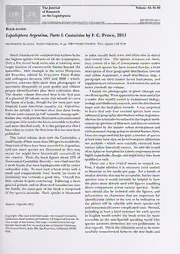
Lepidoptera Argentina, Parte I: Castniidae by F. C. Penco, 2011 PDF
Preview Lepidoptera Argentina, Parte I: Castniidae by F. C. Penco, 2011
The Journal Volume 45: 91-92 of Research LFF JRL on the Lepidoptera ISSN 0022-4324 (print) THE LEPiDOPTERA RESEARCH FOUNDATION, 13 Septembpr 2012 ISSN 215(>-5457 (onune) Book review Lepidoptera Argentina, Parte I: Castniidae hyP. C. Penco, 2011 Distributed by the author. Moron (Argentina), 41 pp. ISBN 978-987-33-0384-5. Price; approx. US$ 25.00 South America is the continent that harbors by far in color, usually both sexes and often also in dorsal the highest species richness of all the Lepidoptera. and ventral view. The species accounts are short; Only a few recent book series aim at covering some they consist of a list of synonymous names under larger fraction of country-wide faunas beyond the which each species has been treated thus far, a brief butterflies. One example is the series Mariposas description of their geographic distribution (overall del Ecuador, edited by Francisco Pinas Rubio and within Argentina), a small distribution map, a and colleagues between 1997 and 2006 - which, paragraph on their known larval host-plants, and however, contains little more than photographs of supplementary information. A references list and an specimens (frequently in poor quality and without index conclude the volume. proper identification) plus their collection data. I found the photographs of good (though not The slender volume discussed here is the first part excellent) quality. What appeared to be most useful for of a planned 20 volume series that intends to cover a reader (like myself) rooted in evolutionary biology, the fauna of a large, though for the most part non- ecology and biodiversity research, were the distribution tropical, Latin American country, viz. Argentina. maps and the host-plant records. I was surprised From the subtitle it becomes clear that these books to learn that only four castniid species have more will not (and cannot) be full ‘scientific monographs’. substantial geographic distributions within Argentina, Rather they shall provide illustrated and commented whereas the remainder is confined to the tropical north¬ catalogues that render the fauna accessible to further eastern tip (province of Misiones) and thus are certainly and more detailed study. It is this perspective that I endangered by the massive urban development and have taken to review the first issue that has now been environmental change going on around Buenos Aires. published. I was also impressed that for quite a number of species This initial volume deals with the Castiniidae, a at least some basic data on larval host-plant affiliations small family of little more than 200 species worldwide. are available - which were carefully extracted from Nine-teen of these have been recorded in Argentina, various (often historical) sources. An odd old record and two more species are illustrated as they may of an Apiaceae host-plant for Geyeria uruguayana seems occur (or might have historically occurred) in highly improbable, though, and might better have been the country. Thus, the book figures about 15% of qualified as such. Neotropical Castniidae diversity - not a bad start for There are a few critical issues to remark on. a moth family that most lepidopterists will be rather First, I doubt whether it is necessary (and useful) unfamiliar with. To start such a book series with a to illustrate so few moths per page. For a family of small and comparatively ‘easy’ family (in terms of modest diversity this may be acceptable, but for more taxonomy) was certainly a good idea. Overall this speciose taxa it would certainly be helpful to have little volume is quite convincing. Following a short the plates more densely used with figures (enabling general prelude and an illustrated introduction into direct comparisons across various species). Scale- the family, the main part of the book is comprised bars should also be included with the figures, and of the species accounts. Each species is illustrated information on characters that are important for identification (either in the text or by indication on the plates) will be valuable with more species-rich Received: 3 September 2012 and taxonomically more complicated taxa. Second, including at least a brief summary for each species Copyright: This work is licensed under the Creative Commons in English would render the book series far more Attribution-NonCommercial-NoDerivs 3.0 Unported License. To accessible to the non-Spanish speaking world (the view a copy of this license, visit http://creativecommons.org/ species accounts themselves are not problematic in licenses/by-nc-nd/3.0/ or send a letter to Creative Commons, that regard). Third, the references need to be more 171 Second Street, Suite 300, San Francisco, California, 94105, USA. carefully cross-checked between the text body and 92 j. Res.I^pid. the references list. I stumbled over a sizeable number Overall, however, this book is a promising start to a of citations in the text which are unfortunately not series on the Lepidoptera of Argentina. I wish this series included in the references list. To give just one a healthy development and very much look forward to example for a species that is nowadays of peculiar seeing additional volumes to appear in print. concern in Europe as an introduced pest of palm trees, Paysandisia archon: of 12 literature sources Literature cited cited in its species account, six are not found in the references list. Moreover, quite a number of papers Rios S.D., & ). M. Gonzalez. 2011. A synopsis of the Castniidae from the last decade on this species of economic (Lepidoptera) of Paraguay. Zootaxa 3055: 43-61. interest were unfortunately not covered as well. The recent synopsis of Castniidae from Paraguay (Rios 8c Konrad Fiedler, Department of Tropical Ecology & Animal Gonzalez, 2011) probably appeared too late in print Biodiversity, University of Vienna, Austria to be included in the reviewed book. kormid.fiedler@univie. ac. at
